Secure Checkout. FREE SHIPPING for Continental U.S. Orders over $60.
Menu
-
- Home
-
About Us
-
The Approach
-
Linking Language & Literacy
-
MindWing Learning
-
Learning Resources
-
SHOP
-
Blog
-
- About MindWing
- Our People
- Contact Us
- Your Account
- Login
-
United States (USD $)
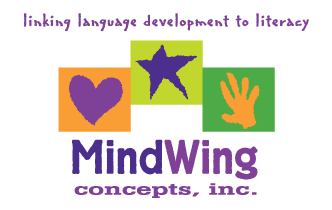
Secure Checkout. FREE SHIPPING for Continental U.S. Orders over $60.

SGM® a Powerful Force in Time of Crisis
March 19, 2020
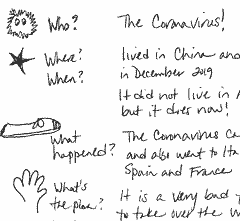 Hello Maryellen, My 4th grade client just completed this during his session—thought you would like to see! I’m not the best at all the ins and outs of Story Grammar Marker® but I wanted you to know how powerful it is for children in this time of unexpected crisis! This client is 10 years old, and diagnosed high-functioning autism spectrum disorder and anxiety disorder. He’s so upset about having to homeschool, in tears at the beginning of the session. Sorry my handwriting isn’t a little more legible, but I was writing in a hurry as he was creating his narrative while holding the student SGM® tool in his hands! By the end of our session, after working things out with SGM®, he generated the three things that are nice about homeschooling—all by himself! I love your work and have happily used SGM® with this client for about a year now, once a week in private speech. Thank you so much for all you do!...
Hello Maryellen, My 4th grade client just completed this during his session—thought you would like to see! I’m not the best at all the ins and outs of Story Grammar Marker® but I wanted you to know how powerful it is for children in this time of unexpected crisis! This client is 10 years old, and diagnosed high-functioning autism spectrum disorder and anxiety disorder. He’s so upset about having to homeschool, in tears at the beginning of the session. Sorry my handwriting isn’t a little more legible, but I was writing in a hurry as he was creating his narrative while holding the student SGM® tool in his hands! By the end of our session, after working things out with SGM®, he generated the three things that are nice about homeschooling—all by himself! I love your work and have happily used SGM® with this client for about a year now, once a week in private speech. Thank you so much for all you do!...

Tech Tuesday: Telling Tales at Varying Developmental Levels
February 03, 2020
 The practice of providing model narratives in order to scaffold personal narratives from students is one that is supported in our literature. Pamela Hadley (1998) describes conversational mapping, or “give a story to get a story,” as critical in language sampling, and these principles can be extended to intervention activities. Westby and Culatta (2016) suggest similar procedures: “Clinicians can model the telling of event narratives and ask children to relate their own experience about a similar event. One clinician told of a time when she did not close the door on her hamster's cage, and the hamster escaped and was never found. The telling of that experience elicited a child's story about a time when he had pet crickets in a cricket cage and the family cat got into the cage and ate the crickets.” We should remember that not every model needs to be a complete episode, though I realized after a recent trip to Utah’s National Parks that I had one ready-to-go. Additionally, this model also demonstrates the synchrony between Story Grammar Marker® and Zones of Regulation®.
The practice of providing model narratives in order to scaffold personal narratives from students is one that is supported in our literature. Pamela Hadley (1998) describes conversational mapping, or “give a story to get a story,” as critical in language sampling, and these principles can be extended to intervention activities. Westby and Culatta (2016) suggest similar procedures: “Clinicians can model the telling of event narratives and ask children to relate their own experience about a similar event. One clinician told of a time when she did not close the door on her hamster's cage, and the hamster escaped and was never found. The telling of that experience elicited a child's story about a time when he had pet crickets in a cricket cage and the family cat got into the cage and ate the crickets.” We should remember that not every model needs to be a complete episode, though I realized after a recent trip to Utah’s National Parks that I had one ready-to-go. Additionally, this model also demonstrates the synchrony between Story Grammar Marker® and Zones of Regulation®.

Tech Tuesday: ASHA Convention Wrap-up, Part 2
January 13, 2020
 In last month’s post (ASHA Wrap-Up, Part 1), I outlined one session from Orlando’s 2019 ASHA Convention that I was involved in, and promised a part 2! For this post, I am going to focus on resources I presented in an additional installment of “Pairing Picture Books and Apps for Contextualized Language Intervention,” a session I have been privileged to present over the last several years, with varying themes. In this session, given the proximity to Epcot, I thought it would be fun to highlight the ways that picture books and apps can be used to “Show Them the World (Knowledge),” meaning work in context to develop both Social Studies and general world or semantic knowledge. In all of my sessions on this topic, I have always emphasized the potential for both books and apps to provide context to develop both story grammar and expository text structure, modeling of course, with Story Grammar Marker® and ThemeMaker® tools and visual graphic organizers. Both macrostructure and microstructure can be emphasized when reviewing the story or information presented in a book or app, along with other skills...
In last month’s post (ASHA Wrap-Up, Part 1), I outlined one session from Orlando’s 2019 ASHA Convention that I was involved in, and promised a part 2! For this post, I am going to focus on resources I presented in an additional installment of “Pairing Picture Books and Apps for Contextualized Language Intervention,” a session I have been privileged to present over the last several years, with varying themes. In this session, given the proximity to Epcot, I thought it would be fun to highlight the ways that picture books and apps can be used to “Show Them the World (Knowledge),” meaning work in context to develop both Social Studies and general world or semantic knowledge. In all of my sessions on this topic, I have always emphasized the potential for both books and apps to provide context to develop both story grammar and expository text structure, modeling of course, with Story Grammar Marker® and ThemeMaker® tools and visual graphic organizers. Both macrostructure and microstructure can be emphasized when reviewing the story or information presented in a book or app, along with other skills...

Let It Snow! Winter-Themed Lessons with Story Grammar Marker®
December 04, 2019
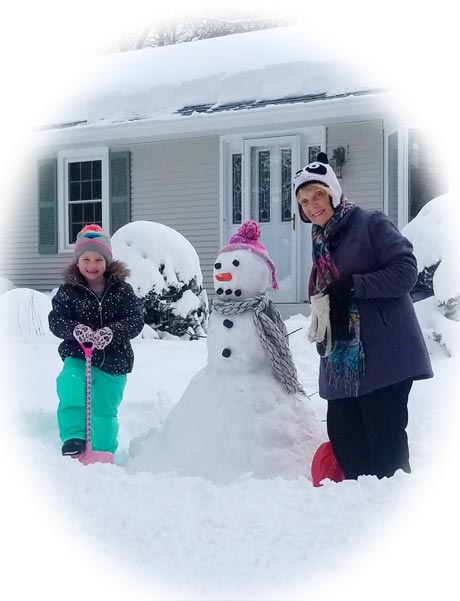 Here in Western Massachusetts, we just had a Thanksgiving weekend storm that dropped 2 FEET of snow in our backyards! It reminded us to share with you links to our past blog posts that contain winter-themed lessons and downloads. Also, we included a comprehensive list of favorite winter-themed books. At left is Maryellen and granddaughter Casey (aged 5) with their snowman.
Here in Western Massachusetts, we just had a Thanksgiving weekend storm that dropped 2 FEET of snow in our backyards! It reminded us to share with you links to our past blog posts that contain winter-themed lessons and downloads. Also, we included a comprehensive list of favorite winter-themed books. At left is Maryellen and granddaughter Casey (aged 5) with their snowman.

Tech Tuesday: More on Memes (Think Halloween!)
October 30, 2019
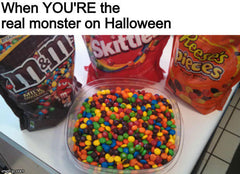 Today’s kids really like memes, digesting them from internet spaces we are too cool to inhabit! Therefore, they serve as a textual or language-infused genre that we can exploit for our students’ engagement. Often a meme suggests some element of a narrative that serves to facilitate a discussion or mapping of other elements. We can compare and contrast these narrative forms with exposition, or explaining ideas (see Thememaker®). When critiquing narrative works such as movies, it’s always felt to be a no-no to have too much exposition, or telling (not showing), such as when a character suddenly explains the mystery inherent to a plot...
Today’s kids really like memes, digesting them from internet spaces we are too cool to inhabit! Therefore, they serve as a textual or language-infused genre that we can exploit for our students’ engagement. Often a meme suggests some element of a narrative that serves to facilitate a discussion or mapping of other elements. We can compare and contrast these narrative forms with exposition, or explaining ideas (see Thememaker®). When critiquing narrative works such as movies, it’s always felt to be a no-no to have too much exposition, or telling (not showing), such as when a character suddenly explains the mystery inherent to a plot...

Character, Settings and Sequencing with Braidy®: Themed Lessons Using “There was an Old Lady…” Series
October 07, 2019
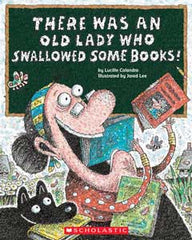 Our talented colleague Danielle Cooper, M.S. CCC-SLP, of Baltimore City Schools gave us permission to share this wonderful lesson using the “There was an Old Lady Who Swallowed A…” series. This series of books, written by Lucille Colandro and illustrated by Jared Lee, shows a woman who swallows random items. Each story rhymes. At the end of each story, those objects are used to create a bigger product aligned with a particular theme. Some of the themes available for the books are Fall, Winter, Thanksgiving, Spring, Halloween, Valentine’s Day, St. Patrick's Day, Beach, Back to School, Birthdays, etc. Each book has the same format: introduction of the character with a sequence of events. These stories are useful for mini rhyming lessons and building thematic vocabulary. They are perfect for introducing the Braidy® Methodology and focusing on Character, Setting, and Sequence of Events (Action Sequence Stage of Narrative Development)...
Our talented colleague Danielle Cooper, M.S. CCC-SLP, of Baltimore City Schools gave us permission to share this wonderful lesson using the “There was an Old Lady Who Swallowed A…” series. This series of books, written by Lucille Colandro and illustrated by Jared Lee, shows a woman who swallows random items. Each story rhymes. At the end of each story, those objects are used to create a bigger product aligned with a particular theme. Some of the themes available for the books are Fall, Winter, Thanksgiving, Spring, Halloween, Valentine’s Day, St. Patrick's Day, Beach, Back to School, Birthdays, etc. Each book has the same format: introduction of the character with a sequence of events. These stories are useful for mini rhyming lessons and building thematic vocabulary. They are perfect for introducing the Braidy® Methodology and focusing on Character, Setting, and Sequence of Events (Action Sequence Stage of Narrative Development)...
